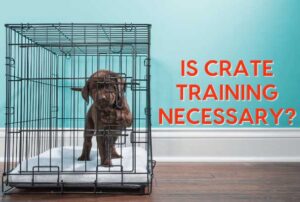Good Manners Makes Happy Dogs
 Crate training is a valuable tool that can be used in conjunction with good manners training to help your dog become a well-behaved and happy member of your family. Here are some reasons why you should consider crate training your dog:
Crate training is a valuable tool that can be used in conjunction with good manners training to help your dog become a well-behaved and happy member of your family. Here are some reasons why you should consider crate training your dog:
1. Safe Space: A crate can provide your dog with a safe and secure space of their own where they can relax and feel comfortable. This is especially helpful for puppies who are still learning to control their bladder and may need a place to rest and prevent accidents.
2. Prevent Destructive Behavior: Crate training can help prevent destructive behaviors such as chewing on furniture or shoes when you’re not able to supervise your dog. By providing them with a crate, you can limit their access to potentially harmful objects and keep your belongings safe.
3. Aid in House Training: Crates can be a valuable tool in house training your dog. Dogs naturally do not like to eliminate in their sleeping area, so by using a crate, you can help establish a routine and encourage your dog to hold their bladder until they are let outside.
4. Travel Safety: Crate training can also be beneficial for travel safety. Whether you’re going on a road trip or to the vet, having your dog comfortable with being in a crate can make the experience less stressful for both you and your furry friend.
Crate Training vs Playpen: Choosing the Right Confinement for Your Dog
Looking for the best way to confine your dog when you can’t supervise them? Overall, crate training can be a positive experience for both you and your dog. It can provide them with a sense of security and help shape them into a well-mannered and happy companion. If you’re unsure about how to start crate training, consider seeking guidance from a professional dog trainer who can help you build a positive and effective training plan.
This guide explores the two most common options: crate training and playpens.
Understanding Confinement
Confinement can be a valuable tool for potty training, preventing destructive behavior, and providing your dog with a safe space to relax. The two main confinement options are:
- Crates: These smaller enclosures offer a den-like feel, promoting security and calmness.
- Playpens: These larger areas provide more space for playing and moving around.
Benefits of Crate Training
- Housebreaking: Crates capitalize on a dog’s natural instinct to avoid soiling their den, accelerating potty training.
- Safe Haven: Crates provide a cozy space for your dog to retreat during stressful situations or when they need a nap.
- Travel-Friendly: Crates act as a familiar and secure environment for your dog during car trips or flights.
Benefits of Playpens
- More Space: Playpens offer ample room for your dog to move around and play with toys.
- Longer Confinement: Playpens are suitable for longer confinement periods when you need to be away for several hours.
- Combined Use: You can place a crate within a playpen to create a designated relaxation zone.
Choosing the Right Option
The best confinement method depends on your dog’s needs and your lifestyle.
Crates are ideal for:
- Potty training puppies
- Dogs who struggle with anxiety
- Traveling with your dog
Playpens are ideal for:
- Dogs who need more space to move
- Situations requiring longer confinement periods
- Housebreaking older dogs who may not need crate-sized confinement
Remember:
- Positive Reinforcement: Always use positive reinforcement techniques like treats and praise to create a positive association with confinement.
- Not a Punishment: Confinement shouldn’t be used for punishment, as this can create negative feelings.
- Supervision: No matter the confinement method, supervision is still crucial, especially for young puppies.

How Big Should Your Dog’s Crate or Confinement Area Be?
When choosing a crate for your dog, it’s best to get one that will fit them at their full adult size. You can use a crate divider to adjust the size as your dog grows. Initially, your puppy should have enough room to stand and turn around comfortably, without extra space that might encourage bathroom accidents. As your puppy matures and learns bladder control, you can gradually increase the crate space.
HOW OFTEN SHOULD YOU USE A CONFINEMENT AREA?
It is recommended to use a confinement area when you need to leave home, cannot actively supervise your pup, or overnight. The general guideline is to limit time in a crate to the dog’s age in months plus one hour, up to about 6 hours. If you’re looking to get your dog comfortable in a crate or confinement area, check out our helpful video guide below. To start, focus on creating a positive association with the crate by providing a food reward and gradually increasing the amount of time your dog spends in the crate. You can also feed your dog meals in the crate or confinement area with the door open to reinforce their comfort. Follow these steps to successfully crate train your puppy or dog.
When is it safe to stop using a crate for your dog?
Confinement is crucial during puppyhood and adolescence when accidents and destructive behavior are common. As your dog matures, you can gradually decrease crate use by allowing short periods of unsupervised time. It’s important to monitor your dog’s behavior through a camera and gradually increase the time as your dog demonstrates good behavior.
Crate Training Mistakes: How to Avoid Overdoing It
Crate training offers numerous benefits for dogs, but like any tool, it can be misused. This guide tackles the common mistake of overusing a crate or playpen, hindering your dog’s development.
The Problem with Over-Confinement
While confinement areas are valuable tools, relying on them excessively can backfire:
- Limited Learning: Dogs confined for extended periods miss opportunities to learn appropriate behavior outside. This can lead to unwanted behaviors like chewing, mouthing, and bursts of energy when released.
- Slowed Potty Training: Puppies confined too long may learn to hold their bladders in the pen, delaying proper potty training outside the confinement area.
- Missed Socialization: Confinement restricts opportunities for your dog to interact with their environment and socialize, leading to potential behavioral issues later on.
Finding the Balance
Here’s how to strike the right balance with confinement:
- Gradual Increase: Start with short confinement periods and gradually increase them as your dog learns proper behavior.
- Supervised Freedom: When not confined, provide supervised playtime and interaction to teach them appropriate ways to interact with their environment.
- Potty Breaks: Schedule regular potty breaks to prevent accidents and solidify proper potty training outside the confinement area.
Alternatives to Over-Confinement
- Puppy-Proofing: Instead of relying solely on confinement, puppy-proof your living space to minimize opportunities for destructive behavior.
- Exercise: Provide your dog with ample exercise to release pent-up energy and promote calmer behavior during non-confined periods.
- Training: Invest in positive reinforcement training to teach your dog desired behaviors, making confinement less necessary over time.
Remember: Confinement is a temporary training tool, not a substitute for proper training and interaction. By finding a balanced approach, you’ll set your dog up for success in all areas of their life.
Consult a Trainer
If you’re unsure about which confinement option is right for your dog, consult a professional dog trainer for personalized guidance.
Read More Articles >>
How To Socialize Your Adult Dog
How To Get Your Dog To Listen To You

